
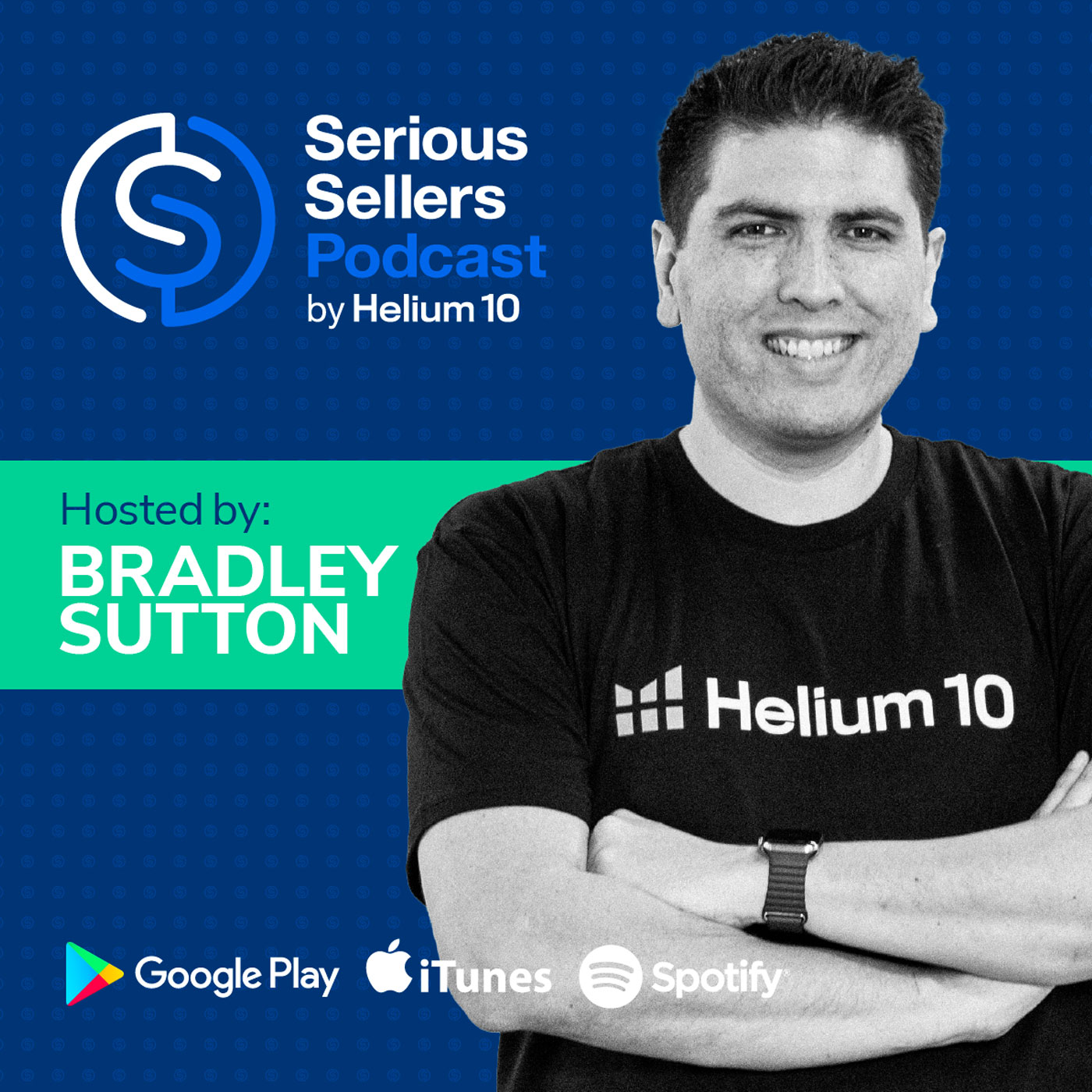
4.1M
Downloads
924
Episodes
Are you an Amazon FBA, TikTok Shop, Walmart, or Ecommerce Seller, or someone interested in becoming one? The Serious Sellers Podcast by Helium 10 is an unscripted, unrehearsed, BS-free, organic conversation between host Bradley Sutton, and real life sellers and thought leaders in the ecommerce world, where they share the top strategies that will help sellers of all levels succeed. In addition, every week there is an episode of the ”Weekly Buzz” which gives a rundown of the latest news in the Ecommerce world. ► Instagram: instagram.com/serioussellerspodcast ► Free Amazon Seller Chrome Extension: https://h10.me/extension ► Sign Up For Helium 10: https://h10.me/signup (Use SSP10 To Save 10% For Life) ► Learn How To Sell on Amazon: https://h10.me/ft ► Watch The Podcasts On Youtube: youtube.com/@Helium10/videos
Episodes
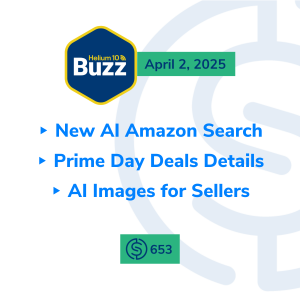
Wednesday Apr 02, 2025
Wednesday Apr 02, 2025
This week on The Weekly Buzz: Amazon's new AI helps shoppers find products by interest, Prime Day deal details revealed, and how AI images are reshaping e-commerce.
► Instagram: instagram.com/serioussellerspodcast
► Free Amazon Seller Chrome Extension: https://h10.me/extension
► Sign Up For Helium 10: https://h10.me/signup (Use SSP10 To Save 10% For Life)
► Learn How To Sell on Amazon: https://h10.me/ft
► Watch The Podcasts On YouTube: youtube.com/@Helium10/videos
We’re back with another episode of the Weekly Buzz with Helium 10’s Principal Brand Evangelist, Carrie Miller. Every week, we cover the latest breaking news in the Amazon, Walmart, and E-commerce space, talk about Helium 10’s newest features, and provide a training tip for the week for serious sellers of any level.
Amazon’s AI-powered ‘Interests’ feature automatically finds new products that match your passions and hobbies
https://www.aboutamazon.com/news/retail/artificial-intelligence-amazon-features-interest
Get ready for Prime Day: Deal scheduling is now open for our longest US Prime Day event ever
https://sellercentral.amazon.com/seller-news/articles/QVRWUERLSUtYMERFUiNHUDNTNVRVU05QWUJITUJN
Walmart Seller Summit 2025
https://www.walmartmarketplacesellersummit.com/event/adb13902-f010-48fe-96c0-64f9d165dba5/welcome
Drive business-to-business growth with new Business Price action panel
https://sellercentral.amazon.com/seller-news/articles/QVRWUERLSUtYMERFUiNHWFpCWVRQSkJIRU5ERlk1
Major Temu move announced for millions of Australian businesses from today
https://au.finance.yahoo.com/news/major-temu-move-announced-for-millions-of-australian-businesses-from-today-211318441.html
Then, we explore the latest updates from Helium 10, with Shivali Patel introducing four new feature alerts. The search query analyzer now supports multiple marketplaces and offers the ability to save filter presets for efficient business management. Integration with Helium 10 Ads allows for enhanced PPC metrics visibility. Lastly, the product launchpad tool is enhanced with adjustable rules, enabling users to tailor the tool to better fit their business strategies and preferences.
This week's strategy highlights Helium 10's new Search Query Analyzer tool, which simplifies filtering and analyzing Amazon search query data. Unlike Seller Central, this tool allows users to compare multiple products, track high-converting keywords, and assess conversion rates against market averages. Additionally, Bradley Sutton will be speaking at two upcoming conferences: Amazon Business Know-How in Warsaw, Poland (April 24-25) and Amazing Days Summit in Sofia, Bulgaria (April 25).
In this episode of the Weekly Buzz by Helium 10, Carrie covers:
- 00:54 - Amazon's AI Interest Feature
- 02:54 - Schedule Prime Day Deals Now
- 06:00 - Walmart Seller Summit 2025
- 06:56 - AI Images
- 09:20 - New B2B Price Panel
- 10:36 - Temu Open to Australian Sellers
- 11:03 - Helium 10 New Feature Alerts
- 16:04 - Strategy Of The Week: Search Query Analyzer Data Imports
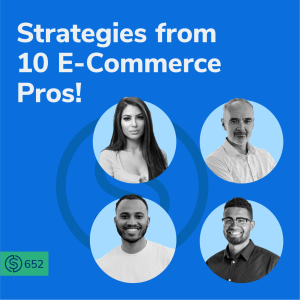
Saturday Mar 29, 2025
#652 - Strategies from 10 E-Commerce Pros!
Saturday Mar 29, 2025
Saturday Mar 29, 2025
Live from the Prosper Show! Get top strategies, tips, and discover a marketplace you never considered selling on. Tune in for expert insights and game-changing advice!
► Instagram: instagram.com/serioussellerspodcast
► Free Amazon Seller Chrome Extension: https://h10.me/extension
► Sign Up For Helium 10: https://h10.me/signup (Use SSP10 To Save 10% For Life)
► Learn How To Sell on Amazon: https://h10.me/ft
► Watch The Podcasts On YouTube: youtube.com/@Helium10/videos
Join us as we bring you a special podcast recording from the Prosper Show in Las Vegas, where we sit down with multiple guests starting with Michael Shaffa, an accomplished Amazon seller who has transformed his company's e-commerce strategy. Michael shares his journey from selling only a few units per month to achieving $1.2 million in annual sales. Learn how his team harnessed tools like Helium 10 and strategies such as keyword indexing and the Maldives Honeymoon launch strategy to find success. Michael's story underscores the significance of understanding your target market and adapting your strategies, shifting focus from a general audience to a specialized niche, and leveraging graphic design to create engaging authentic content.
We also explore the role of AI in revolutionizing various aspects of Amazon selling with Kevin King. Discover how AI agents transform customer service, PPC, and product sourcing, potentially automating significant portions of an Amazon seller's business. As the industry evolves, these technologies promise significant advancements. Additionally, the episode touches on the psychology of marketing and its impact on sales strategies.
At the Prosper Show, we spoke with Vivian Sun, head of business development at Shein Marketplace, about their expanding platform. While Shein is widely known as a D2C fashion brand, it has been developing a marketplace over the past two years, inviting local sellers to offer products beyond clothing. Shein Marketplace now supports a wide range of categories, including beauty, home goods, electronics, and even food and supplements. With a flat 10% fees and flexible fulfillment options, including self-shipping and Amazon MCF, sellers have multiple ways to operate. Interested sellers can sign up through the Shein Marketplace website or connect with Vivian (Wenjia Sun) and her team via LinkedIn.
Finally, we explore effective bidding strategies and the importance of brand awareness in advertising campaigns. With insights from industry veterans, including Bojan Gajic, former CEO and CTO of Helium 10 and now CEO at Avask. You'll learn the benefits of low bids and branding campaigns. The episode also introduces an upcoming initiative called "Expansion Ticket," designed to guide sellers in expanding their businesses internationally. As we navigate these strategies and innovations, we emphasize the importance of leveraging expertise and existing knowledge to grow in the competitive e-commerce landscape.
In episode 652 of the Serious Sellers Podcast, Bradley and his guests discuss:
- 00:00 - Amazon Seller Strategies at Prosper Show
- 05:53 - Smart Showdown
- 06:27 - AI Agents and Shein Marketplace Expansion
- 17:28 - Amazon Success Strategies With Lem Turner
- 17:59 - Amazon Brand Strategies and Advertising Success
- 25:28 - Amazon Expansion Strategies for Growth
- 30:35 - Amazon Seller Success Story
- 35:35 - Keyword Research and UGC Impact
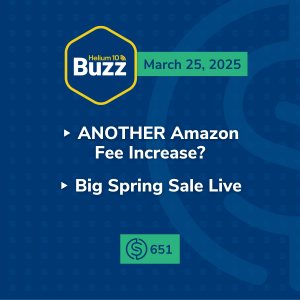
Tuesday Mar 25, 2025
Tuesday Mar 25, 2025
Amazon is raising fees again. The Amazon big spring sale is now live. These buzzing stories and more on today's episode!
► Instagram: instagram.com/serioussellerspodcast
► Free Amazon Seller Chrome Extension: https://h10.me/extension
► Sign Up For Helium 10: https://h10.me/signup (Use SSP10 To Save 10% For Life)
► Learn How To Sell on Amazon: https://h10.me/ft
► Watch The Podcasts On YouTube: youtube.com/@Helium10/videos
We’re back with another episode of the Weekly Buzz with Helium 10’s VP of Education and Strategy, Bradley Sutton. Every week, we cover the latest breaking news in the Amazon, Walmart, and E-commerce space, talk about Helium 10’s newest features, and provide a training tip for the week for serious sellers of any level.
Amazon is making it easier to try using deals and coupons to create additional demand for your products
https://sellercentral.amazon.com/seller-news/articles/QVRWUERLSUtYMERFUiNHM0EyTUgyRjQ1S1lZRzY2
Amazon’s Big Spring Sale 2025 starts March 25
https://www.aboutamazon.com/news/retail/amazon-big-spring-sale-2025
AI startup Perplexity confirms interest to buy TikTok
https://techxplore.com/news/2025-03-ai-startup-perplexity-buy-tiktok.html
Catch Bradley Sutton at the Prosper Show!
https://www.linkedin.com/posts/h10bradley_see-you-guys-at-prosper-this-week-here-activity-7310218411182026752-m4Al?
For our new feature alerts, Helium 10 has introduced two highly requested features in Blackbox. The first caters to wholesale and arbitrage sellers, allowing them to search products using UPC, EAN, or GTIN codes, even by uploading bulk lists of 200–300+ identifiers. This streamlines the process of evaluating wholesale opportunities by quickly identifying which products are on Amazon and their estimated sales. The second feature is designed for Amazon influencers, enabling them to find high-ROI products for video content. By switching to “Influencer Mode,” users can filter products by category, price range, reviews, and the number of videos in the carousel, helping them identify listings where they have a strong chance of earning commissions.
Lastly, our strategy of the week features Helium 10’s Keyword Sales Estimate feature, which goes beyond search volume to show the actual sales estimates a keyword generates. This helps sellers prioritize high-converting keywords instead of just high-traffic ones, ultimately improving ad efficiency and product targeting. For instance, while two keywords may have similar search volumes, one might convert at a much higher rate due to buyer intent. This level of insight, exclusive to Helium 10, ensures sellers focus on terms that drive actual sales. If you’re headed to the Prosper Show in Las Vegas, don't miss out on the chance to meet us and share your story—there might even be a spot for you on the Serious Sellers Podcast!
In this episode of the Weekly Buzz by Helium 10, Bradley covers:
- 00:38 - Coupons/Deals Skyrocket?
- 17:25 - Big Spring Sale
- 18:31 - TikTok Buyer?
- 19:31 - Prosper Show
- 20:22 - Helium 10 New Feature Alerts
- 24:24 - Strategy of the week: Keyword Sales Estimates
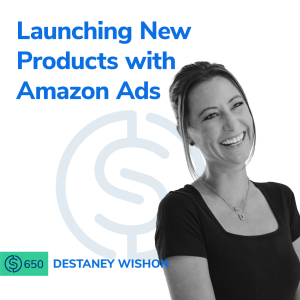
Saturday Mar 22, 2025
#650 - Launching New Products with Amazon Ads
Saturday Mar 22, 2025
Saturday Mar 22, 2025
Ready to launch your Amazon product? In this episode, we discuss the essentials of optimizing your listings and the best ad strategies for driving more sales immediately.
► Instagram: instagram.com/serioussellerspodcast
► Free Amazon Seller Chrome Extension: https://h10.me/extension
► Sign Up For Helium 10: https://h10.me/signup (Use SSP10 To Save 10% For Life)
► Learn How To Sell on Amazon: https://h10.me/ft
► Watch The Podcasts On YouTube: youtube.com/@Helium10/videos
Join us in our monthly TACoS Tuesday episode, as we explore the essentials of launching Amazon products, featuring expert insights from Destaney Wishon. We start by discussing how to make your product retail-ready, emphasizing the importance of indexing your listing for the right keywords to drive sales. From match types and targeting to effective keyword research methods often overlooked by sellers, we cover fundamental Amazon advertising strategies for 2025. With Destaney's extensive expertise in Amazon PPC and Bradley Sutton’s experience launching over 600 products, they provide valuable guidance for both new and seasoned Amazon sellers.
Listen in as they navigate the ever-changing landscape of Amazon advertising. They recount the evolution of strategies from two-step URLs and giveaways to modern methods that are currently non-compliant with Amazon's TOS. By sharing Bradley’s recent success story of achieving top keyword rankings within three weeks, they provide practical insights into adapting to market dynamics while leveraging core strategies for sustained success. They also focused on optimizing keywords for seasonal products, using mason jars as an example to illustrate the need for specificity in targeting audiences and identifying seasonal trends and opportunity keywords.
Finally, let’s tackle the art of optimizing Amazon PPC strategies, focusing on understanding customer feedback and incorporating emotional touchpoints into product listings. They discuss bid management strategies, the importance of balancing profitability and scalability, and how successful bidding can enhance organic ranking. Additionally, they cover the significance of tailoring marketing strategies to fit specific product niches and maintaining brand loyalty amidst the shift from organic to paid search on Amazon. Throughout the episode, we aim to equip you with actionable insights and strategies to boost your product's visibility and success on Amazon.
In episode 650 of the Serious Sellers Podcast, Bradley and Destaney discuss:
- 00:02 - Amazon Advertising Launch Strategies Workshop
- 01:22 - Navigating Amazon's Ever-Changing Advertising Landscape
- 10:08 - Optimizing Keywords for Seasonal Products
- 13:12 - Keyword Research Using Helium 10
- 18:41 - Optimizing Amazon Advertising Strategy
- 24:49 - Importance of Keyword Research in Advertising
- 26:52 - Effective Bid Management for Targeting Types
- 28:50 - Finding Balance in Amazon Bid Management
- 35:37 - Bid Management for Sales and ACoS
- 38:23 - Mastering Amazon Bidding Strategy
- 45:41 - Discussion on Algorithmic Love and Relaunch
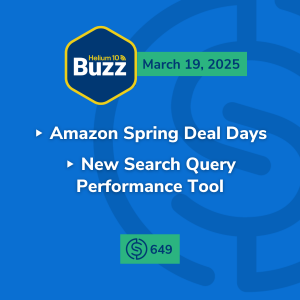
Wednesday Mar 19, 2025
#649 – Amazon Spring Deal Days & New Search Query Performance Tool | Weekly Buzz 3/19/25
Wednesday Mar 19, 2025
Wednesday Mar 19, 2025
Upcoming spring day events, Amazon ads integrating with Adobe Photoshop, and Walmart's got an AI guy of its own. These and more buzzing news on this week's episode!
► Instagram: instagram.com/serioussellerspodcast
► Free Amazon Seller Chrome Extension: https://h10.me/extension
► Sign Up For Helium 10: https://h10.me/signup (Use SSP10 To Save 10% For Life)
► Learn How To Sell on Amazon: https://h10.me/ft
► Watch The Podcasts On YouTube: youtube.com/@Helium10/videos
We’re back with another episode of the Weekly Buzz with Helium 10’s VP of Education and Strategy, Bradley Sutton. Every week, we cover the latest breaking news in the Amazon, Walmart, and E-commerce space, talk about Helium 10’s newest features, and provide a training tip for the week for serious sellers of any level.
Amazon, Walmart to host spring savings events
https://chainstoreage.com/amazon-walmart-host-spring-savings-events
Amazon Spring Deal Days 2025 is coming March 25-31
https://www.aboutamazon.eu/news/retail/amazon-spring-deal-days-2025-is-coming-march-25-31
Prepare for Prime Day: Send your inventory to AWD by May 15
https://sell.amazon.com/blog/awd-prime-day-prep
New Product: Exciting news from the AdobeSummit! Amazon Ads announced it’s expanding your creative possibilities through a new partnership with Adobe Photoshop and Adobe Express. Soon, you’ll be able to access your Amazon Creative Assets library and leverage our pre-moderation capabilities directly within these Adobe tools.
Via Jeff Cohen on LinkedIn
Walmart Develops GenAI-Powered Assistant for Walmart Merchants
https://corporate.walmart.com/news/2025/03/18/walmart-develops-genai-powered-assistant-for-walmart-merchants
Amazon launches Amazon.ie in Ireland
https://www.aboutamazon.com/news/retail/amazon-ireland
Request to remove meltable FBA inventory by April 15, 2025
https://sellercentral.amazon.com/seller-news/articles/QVRWUERLSUtYMERFUiNHUTZGWExSWUhXUlhFWEFV
Forever 21 store closures accelerated by competition from Shein and Temu
https://www.foxbusiness.com/retail/forever-21-store-closures-accelerated-competition-from-shein-temu
Join the TikTok Shop Sellers Group by Helium 10 - https://h10.me/tiktokgroup
Enhance your competitive edge with Helium 10's new powerful tool, the Search Query Performance Analyzer, offering an in-depth look into Amazon’s SQP data and more. Discover how monitoring keyword fluctuations inside Cerebro, such as with "emo decor" and "coffin decor," can be pivotal in maintaining or boosting sales momentum. By understanding the link between keyword trends and sales, you'll gain invaluable insights for forecasting and strategy adjustments, ensuring you stay ahead in the competitive e-commerce landscape.
In this episode of the Weekly Buzz by Helium 10, Bradley covers:
- 00:45 - Spring Deal Days
- 04:42 - Amazon Ads x Adobe
- 06:28 - Walmart's AI Revolution
- 07:59 - Amazon Expands to Ireland
- 10:17 - Meltable Inventory Purge
- 11:38 - Goodbye Forever 21
- 13:01 - TikTok Shop Sellers Group by Helium 10
- 13:39 - Helium 10 New Feature: Search Query Performance Analyzer Tool
- 23:41 - Strategy of the Week: Cerebro Historical Trend Monthly Comparison
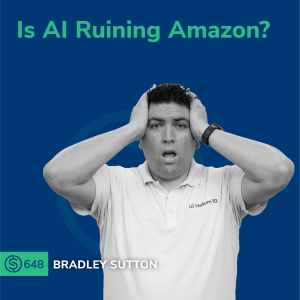
Saturday Mar 15, 2025
#648 - Is AI Ruining Amazon?
Saturday Mar 15, 2025
Saturday Mar 15, 2025
Is AI changing the game on Amazon—for better or worse? Discover the right and wrong ways to leverage AI in e-commerce and how smart strategies could boost your sales by 30% or more!
► Instagram: instagram.com/serioussellerspodcast
► Free Amazon Seller Chrome Extension: https://h10.me/extension
► Sign Up For Helium 10: https://h10.me/signup (Use SSP10 To Save 10% For Life)
► Learn How To Sell on Amazon: https://h10.me/ft
► Watch The Podcasts On YouTube: youtube.com/@Helium10/videos
Is artificial intelligence reshaping Amazon selling for the better or leading it astray? In this episode, we scrutinize the nuanced impact of AI on Amazon sellers, posing the provocative question of whether AI is indeed ruining Amazon. We dive into the labyrinth of AI's potential benefits—boosting sales and streamlining operations—while also exposing the risks of over-reliance on AI without human input and data. As AI tools like ChatGPT become more prevalent in product and keyword searches, we emphasize the crucial role of specialized tools such as Helium 10 in ensuring accuracy and effectiveness.
Our discussion highlights the pitfalls and promises of using AI for Amazon keyword and product research. Through real-world examples, we dissect the challenges that arise when relying solely on AI-generated data, underscoring the necessity of feeding AI robust and relevant information. Exploring the risks of AI-written Amazon listings, we stress the importance of informed technology use to achieve optimal results. By illustrating the limits of AI tools in identifying trending products and optimizing listings, we advocate for a balanced approach—melding AI's capabilities with human oversight and specialized data.
Finally, we turn our focus to enhancing the synergy between AI and Helium 10 for your Amazon brand’s success. Through a case study of a wooden snack organizer, we demonstrate the power of integrating comprehensive data with AI to boost keyword indexing. With insights from Andrew Bell's customized GPT tool, we reveal pathways to even greater performance. We invite listeners to engage in this conversation, sharing their thoughts and experiences on enhancing AI integration to better serve the community's needs. Whether you're a seasoned seller or a curious newbie, this episode offers valuable insights into harnessing AI's power with precision and care.
In episode 648 of the Serious Sellers Podcast, Bradley talks about:
- 00:00 - AI Usage in Amazon Selling
- 03:44 - AI's Impact on Amazon Sellers
- 06:56 - Using Amazon Tools for Product Research
- 12:08 - High Demand Snack Bar Organizer Product
- 15:09 - Amazon Algorithm Changes and Keyword Indexing
- 18:50 - Importance of Keywords in Listing
- 19:09 - Optimizing Amazon Listings With AI
- 21:57 - Keyword Optimization for Amazon Listings
- 27:29 - Optimizing Amazon Listings With AI + Helium 10 Data
- 31:22 - Andrew Bell's GPT Boosts Listing Performance
- 35:18 - Enhancing AI Integration for Brand Success
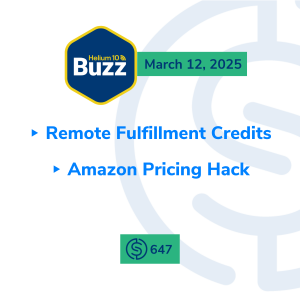
Wednesday Mar 12, 2025
#647 – Remote Fulfillment Credits and Amazon Pricing Hack | Weekly Buzz 3/12/25
Wednesday Mar 12, 2025
Wednesday Mar 12, 2025
Amazon is giving sellers a credit for FBA. Another Chinese marketplace is gaining market share. There's a new way to make money with Helium 10. These buzzing stories & more on this episode!
► Instagram: instagram.com/serioussellerspodcast
► Free Amazon Seller Chrome Extension: https://h10.me/extension
► Sign Up For Helium 10: https://h10.me/signup (Use SSP10 To Save 10% For Life)
► Learn How To Sell on Amazon: https://h10.me/ft
► Watch The Podcasts On YouTube: youtube.com/@Helium10/videos
We’re back with another episode of the Weekly Buzz with Helium 10’s VP of Education and Strategy, Bradley Sutton. Every week, we cover the latest breaking news in the Amazon, Walmart, and E-commerce space, talk about Helium 10’s newest features, and provide a training tip for the week for serious sellers of any level.
New return credits for Remote Fulfillment with FBA
https://sellercentral.amazon.com/seller-news/articles/QVRWUERLSUtYMERFUiNHWFpKODlZQUhLSjRQRjha
How to get free delivery on Amazon
https://www.aboutamazon.com/news/retail/amazon-free-delivery
New recommended product groups for Ships in Product Packaging program
https://sellercentral.amazon.com/seller-news/articles/QVRWUERLSUtYMERFUiNHSjQ4SkdTRjNWNVlBQUYz
TikTok To Integrate More 'Local Services' Into Its US Commerce Push
https://www.mediapost.com/publications/article/403951/tiktok-to-integrate-more-local-services-into-its.html
Goodbye Amazon and Temu – Aliexpress is ahead of the game in bringing these incredible deals to technology
https://eladelantado.com/news/aliexpress-spring-tech-sales-2025/
Plus, we talk about Helium 10's affiliate program, offering lifetime commissions for those who refer new users, and our new Facebook group for Amazon & TikTok influencers to foster community and knowledge sharing. To wrap things up, we highlight the latest features of the Helium 10 Chrome extension, including a new visual search tool that uses images to find similar products on Amazon, enhancing your product research and discovery efforts. Don't miss out on these insights and strategies designed to elevate your e-commerce skills.
In this episode of the Weekly Buzz by Helium 10, Bradley covers:
- 00:59 - FBA Return Credits
- 02:35 - FBM Pricing Hack
- 05:12 - SIPP Program
- 06:19 - TikTok Local
- 08:00 - Ali Express
- 09:15 - Helium 10 Referral Program - h10.me/crushit
- 10:55 - Influencer FB Group - h10.me/influencerFB
- 11:49 - Helium 10 New Feature Alerts
- 13:52 - Strategy of the Week: Child ASIN Variation Sales Performance
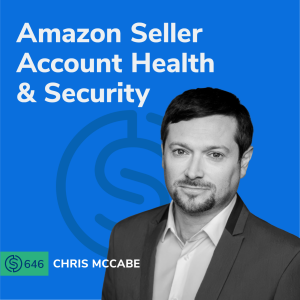
Saturday Mar 08, 2025
#646 - Amazon Seller Account Health & Security
Saturday Mar 08, 2025
Saturday Mar 08, 2025
Have you heard lately of people who've had their Amazon accounts hacked? In this episode, we'll discuss different methods for keeping your Amazon accounts safe.
► Instagram: instagram.com/serioussellerspodcast
► Free Amazon Seller Chrome Extension: https://h10.me/extension
► Sign Up For Helium 10: https://h10.me/signup (Use SSP10 To Save 10% For Life)
► Learn How To Sell on Amazon: https://h10.me/ft
► Watch The Podcasts On YouTube: youtube.com/@Helium10/videos
Amazon seller account security has never been more critical. What if your business could be halted by a single phishing scam or misplaced credential? In light of recent hacking incidents, we've invited Chris McCabe from EcommerceChris to share expert advice on fortifying your Amazon accounts. He uncovers common mistakes sellers make, such as sharing credentials and missing out on two-factor authentication, and offers actionable steps to avoid them. Join us as we discuss the importance of creating unique user permissions, the necessity of revoking access when it's no longer needed, and the benefits of deploying tools like Helium 10 Alerts to monitor and protect your accounts.
Navigating the aftermath of an account flagged as compromised can be daunting, but it doesn't have to spell disaster. We explore strategies for quick resolution, including the right Amazon teams to contact and how SAS Core representatives can assist in regaining control. Chris provides insights into managing accounts that are linked to both buyer and seller profiles and shares advice on keeping them secure. We also address the use of VPNs while traveling and the potential impact on account visibility, stressing the importance of maintaining primary email access for appeals.
Managing multiple Amazon accounts doesn't have to be risky if done correctly. Discover why using subaccounts with unique logins and enabling two-factor authentication is vital for security. We'll also discuss leveraging remote servers to protect personal devices while handling admin tasks. For sellers looking to expand, we touch on the potential within the arts and crafts category despite inflationary pressures, offering tips on finding low-competition niches. To wrap up, we highlight how Helium 10 Black Box can be an invaluable tool for effective product research, helping you identify seasonal top sellers and capitalize on market trends. Tune in to ensure your Amazon selling endeavors are both secure and successful.
In episode 646 of the Serious Sellers Podcast, Bradley and Chris discuss:
- 00:00 - Keeping Amazon Accounts Safe
- 04:40 - Amazon-Related Account Security Concerns
- 08:36 - Resolving Amazon Account Compromise Quickly
- 12:34 - Amazon Account Termination Warning
- 14:43 - Preventing Amazon Account Compromises
- 17:58 - Secure Amazon Admin Account Setup
- 22:57 - Amazon Account Responsibility Clarity
- 24:16 - Managing Multiple Amazon Accounts Securely
- 33:09 - Questioning Competitors' Tactics on Amazon
- 34:10 - Utilizing Helium 10 for Product Research
- 38:00 - Product Analysis for Top Keywords
- 40:42 - Identifying Seasonal Top Sellers for Amazon
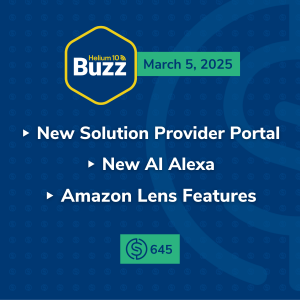
Wednesday Mar 05, 2025
Wednesday Mar 05, 2025
There are new changes to how Amazon agencies and service providers can access client accounts and a new date change for FBA reimbursement policies. These and more buzzing news on this week's episode!
► Instagram: instagram.com/serioussellerspodcast
► Free Amazon Seller Chrome Extension: https://h10.me/extension
► Sign Up For Helium 10: https://h10.me/signup (Use SSP10 To Save 10% For Life)
► Learn How To Sell on Amazon: https://h10.me/ft
► Watch The Podcasts On YouTube: youtube.com/@Helium10/videos
We’re back with another episode of the Weekly Buzz with Helium 10’s VP of Education and Strategy, Bradley Sutton. Every week, we cover the latest breaking news in the Amazon, Walmart, and E-commerce space, talk about Helium 10’s newest features, and provide a training tip for the week for serious sellers of any level.
Amazon’s Solution Provider Portal (SPP) is a dedicated gateway for third-party developers and service providers to onboard and manage their offerings for Amazon seller and vendor customers.
https://developer.amazonservices.com/solution-provider-portal
You can now use a credit card as your Walmart Marketplace billing method.
https://marketplacelearn.walmart.com/guides/Taxes%20%26%20payments/Billing%20Information/Billing-Methods:-Add-a-credit-card
New effective date for FBA inventory reimbursement policy
https://sellercentral.amazon.com/seller-news/articles/QVRWUERLSUtYMERFUiNHVkYyU0M5NldVQ1BWQ0NO
Track and prevent product return badges
https://sellercentral.amazon.com/seller-news/articles/QVRWUERLSUtYMERFUiNHMlZVVzZXTkc4N1Q0OEtD
TikTok Shop welcomes merchants in Germany, France, and Italy
https://ecommercenews.eu/tiktok-shop-welcomes-merchants-in-germany-france-and-italy/
Amazon eyes global expansion for its Temu, Shein competitor
https://www.cnbc.com/2025/02/28/amazon-eyes-global-expansion-for-its-temu-shein-competitor.html
Amazon Introduces Alexa+, the next generation of Alexa
https://www.aboutamazon.com/news/devices/new-alexa-generative-artificial-intelligence
4 ways to shop faster on Amazon using Amazon Lens
https://www.aboutamazon.com/news/retail/how-to-use-amazon-lens
Helium 10 has been recognized as a Walmart Connect Partner Program - Premium Partner!
In our new feature alerts, Helium 10's new eBay Price Checker lets you instantly compare Amazon vs. eBay prices to prevent buy box issues and spot unauthorized resellers. Lastly, Helium 10's Keyword Tracker with Boost checks your keyword ranks 24x daily, showing real-time fluctuations across browsers and locations—crucial for tracking launches and ad performance. Stay ahead by monitoring your most important keywords hourly!
In this episode of the Weekly Buzz by Helium 10, Carrie covers:
- 00:52 - Solution Provider Portal
- 02:51 - Now You can use WM CC
- 04:10 - FBA Reimbursement Update
- 05:31 - Amazon Return Badge
- 07:06 - TikTok Shop Europe
- 08:16 - Amazon Haul Global Expansion
- 10:39 - Next Gen Alexa
- 13:07 - Amazon Lens Updates
- 15:00 - Update Emergency Contact
- 15:50 - Walmart Connect Update
- 16:36 - Helium 10’s eBay Price Checker
- 18:07 - Keyword Tracker with Boost
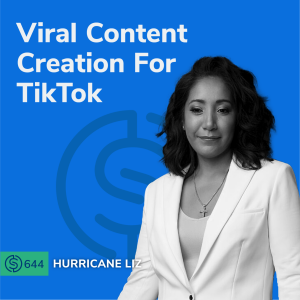
Saturday Mar 01, 2025
#644 - Viral Content Creation For TikTok
Saturday Mar 01, 2025
Saturday Mar 01, 2025
Discover how sellers generate millions in sales on TikTok Shop in just days! Our guest, Liz Herrera, shares her strategies for helping creators go viral on TikTok.
► Instagram: instagram.com/serioussellerspodcast
► Free Amazon Seller Chrome Extension: https://h10.me/extension
► Sign Up For Helium 10: https://h10.me/signup (Use SSP10 To Save 10% For Life)
► Learn How To Sell on Amazon: https://h10.me/ft
► Watch The Podcasts On Youtube: youtube.com/@Helium10/videos
Join us for an exciting conversation on the Serious Sellers Podcast by Helium 10, where we explore strategies for going viral on TikTok and harnessing its e-commerce potential. Our special guest, Liz Herrera aka "Hurricane Liz," a seasoned e-commerce entrepreneur, shares her incredible journey from selling Pokémon cards in her college dorm room to becoming a successful figure in the Amazon world. Liz opens up about her early ventures in retail arbitrage, the challenges she faced during the Black Friday poker incident, and how she adapted by launching her first private-label product. Her story is one of resilience and adaptability, offering valuable insights into building a thriving online business.
Listen in as we discuss the evolution of TikTok as a powerful platform for business growth, transitioning from organic reach to leveraging TikTok Shop. We'll explore the nuances of working with influencers and creators, as well as strategies for managing these relationships effectively. Learn how businesses can build in-house content creation teams to reduce reliance on costly external creators and adapt to the ever-changing landscape of TikTok Shop and influencer marketing. An upcoming event in Vegas will also be highlighted, focusing on taking control of content to maximize commercial opportunities.
Finally, we'll uncover the potential of AI in marketing and sales, challenging traditional notions of content creation. Discover how AI can be leveraged to generate a high volume of content on platforms like TikTok, enhancing brand presence and driving sales. We share practical tips for maximizing TikTok strategy, such as using multiple accounts and the shotgun approach in advertising. Be inspired by a success story where a client generated $1.5 million in just four days through strategic e-commerce tactics. Join us to gain a comprehensive understanding of TikTok's e-commerce potential and learn how to implement these strategies for brand growth.
In episode 644 of the Serious Sellers Podcast, Bradley and Liz discuss:
- 00:00 - Strategies for Going Viral on TikTok
- 04:13 - From Thrift Stores to Private Label
- 08:32 - Navigating TikTok Shop and Influencers
- 12:35 - Tapping Into TikTok's E-Commerce Potential
- 13:57 - AI-driven Brand Growth Strategy
- 20:54 - Standing Out to Influencers on TikTok
- 23:43 - Maximizing TikTok Strategy for Brand Growth
- 24:36 - Monetizing TikTok Reach & Strategies
- 27:52 - AI With Green Screen Strategy
Enjoy this episode? Be sure to check out our previous episodes for even more content to propel you to Amazon FBA Seller success! And don’t forget to “Like” our Facebook page and subscribe to the podcast on iTunes, Spotify, or wherever you listen to our podcast.
Get snippets from all episodes by following us on Instagram at @SeriousSellersPodcast
Want to absolutely start crushing it on Amazon? Here are few carefully curated resources to get you started:
- Freedom Ticket: Taught by Amazon thought leader Kevin King, get A-Z Amazon strategies and techniques for establishing and solidifying your business.
- Helium 10: 30+ software tools to boost your entire sales pipeline from product research to customer communication and Amazon refund automation. Make running a successful Amazon or Walmart business easier with better data and insights. See what our customers have to say.
- Helium 10 Chrome Extension: Verify your Amazon product idea and validate how lucrative it can be with over a dozen data metrics and profitability estimation.
SellerTrademarks.com: Trademarks are vital for protecting your Amazon brand from hijackers, and sellertrademarks.com provides a streamlined process for helping you get one.